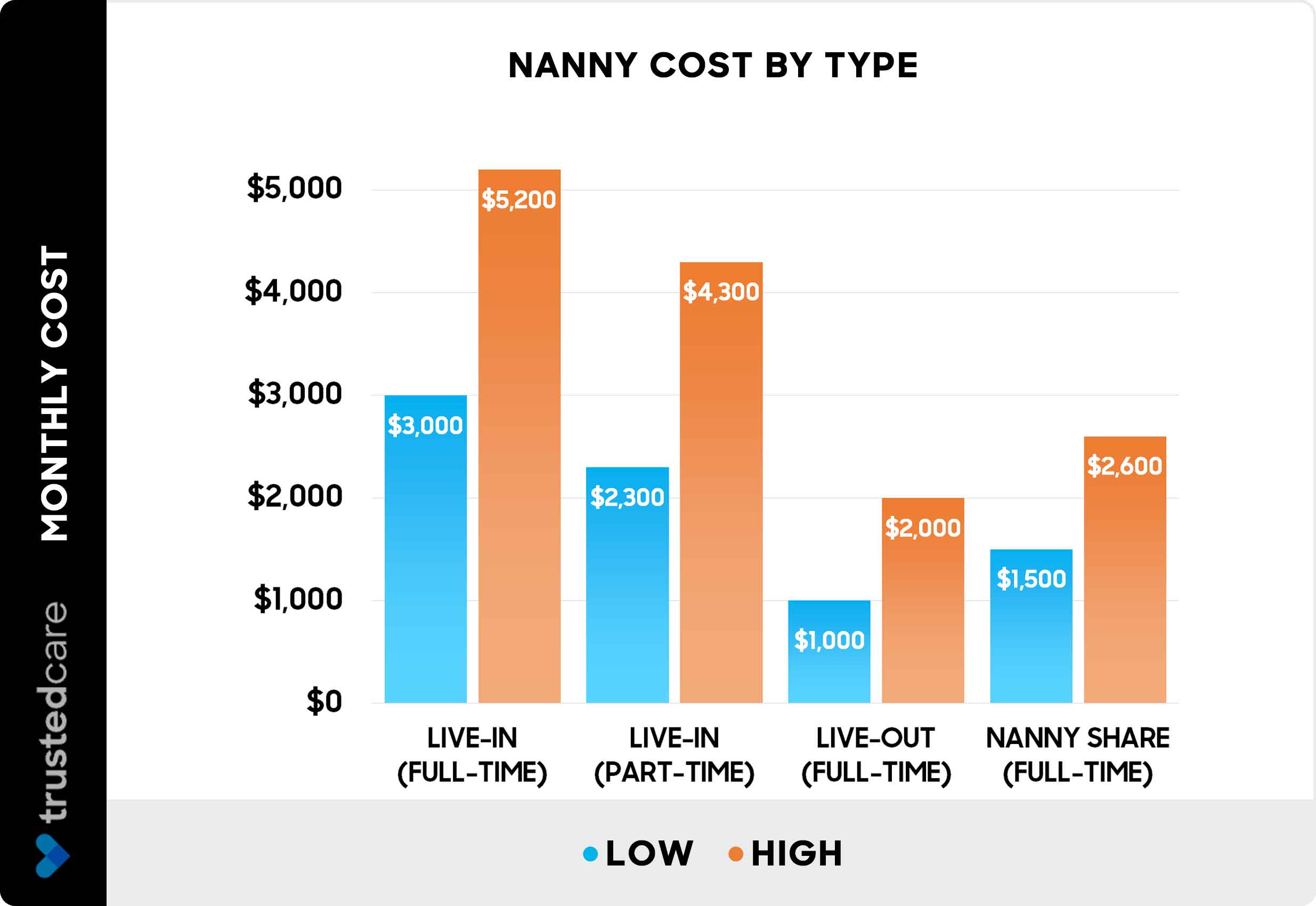
How much does a live-in nanny cost?
How much does a live-in nanny cost?
$14 – $20 per hour
$700 – $1,200 per week
$3,000 – $5,200 per month
$36,000 – $62,000 per year
Live-in nanny cost
A live-in nanny costs $14 to $20 per hour on average. A full-time, in-home nanny's salary is $3,000 to $5,200 per month or $36,000 to $62,000 per year, plus room and board. Live-in nanny salaries depend on their experience, location, and the number and ages of children in care.
| Nanny type | Hours per week | Weekly cost | Details |
|---|---|---|---|
| Live-in | 50 – 60 | $700 – $1,200 |
|
| Au pair | 45 or less | $150 – $250 minimum “pocket money” |
|
Au pair vs. live-in nanny cost
An au pair costs $150 to $250 per week in pocket money, plus room and board. Host families also spend $8,500 to $10,500 per year to participate in the cultural exchange program. The State Department strictly regulates hours and pay, including the cost of a language course up to $1,000.

Live-out vs. live-in nanny cost
A live-out nanny costs $15 to $25 per hour, with mandatory paid overtime and no room and board included. As a cheaper alternative, a nanny share costs $10 to $15 per hour per family. Sharing a nanny with another family reduces childcare costs and adds the benefit of socialization with other children.

| Type | Hourly rate | Cost per week | Cost per month |
|---|---|---|---|
| Live-in nanny (Full-time, 50 – 60 hours) | $14 – $20 | $700 – $1,200 | $3,000 – $5,200 plus room & board |
| Live-out nanny (Full-time, 35 – 40 hours) | $15 – $25 | $525 – $1,000 | $2,300 – $4,300 |
| Live-out nanny (Part-time, 20 hours) | $12 – $24 | $240 – $480 | $1,000 – $2,000 |
| Nanny share (Full-time, 35 – 40 hours) | $10 – $15 per family | $350 – $600 | $1,500 – $2,600 |
Cost factors of a live-in nanny
Live-in nannies are typically paid at the regular nanny rate or slightly less, plus room and board. Additional factors affecting the cost include:
Age & number of children – Infant care costs 15% to 20% more than care for school-aged children. Caring for additional children increases hourly rates by $1 to $3 per hour, per child.
Benefits – Full-time nannies earn benefits including paid time off, health insurance, annual raises, holiday bonuses, and overtime pay of time-and-a-half for hours over 40 per week.
Certifications and qualifications – Nannies with higher education, safety, and health certifications, including CPR and First aid, typically charge a higher hourly rate.
Experience and education – Nannies with an early childhood education degree or years of experience charge $3 to $6 more per hour.
Geographic location – Metropolitan areas with a higher cost of living have higher salaries.
Workers’ compensation insurance – Any household employer is required to carry worker’s compensation insurance costing $300 to $900 per year. The plan covers an injured worker’s medical expenses and lost wages while they are unable to work.
Other services
Homework help and tutoring costs $25 to $80 per hour.
Housework & house cleaning costs $25 to $50 per hour.

Live-in nanny work hours & responsibilities
A live-in nanny often works extended hours of 10 to 12 hours per day, up to 6 days per week. Nannies should be paid for every hour they work, including “on call” hours. Most states do not require overtime pay for live-in nannies.
Responsibilities of a live-in nanny typically include:
Household tasks like cooking, laundry, cleaning, or dog-walking
Errands like grocery shopping or picking up the dry cleaning
Transporting the children to school and other activities
Managing contractors or other household employees
Do live-in nannies pay rent?
A live-in nanny should not pay rent. Room and board are a benefit and should not reduce the nanny’s hourly pay rate. However, in some states, parents may deduct $6 per day for meals and up to $35 per week for rent from the nanny’s pay.
Do you pay live-in nanny taxes?
Parents must pay 7.65% in Social Security and Medicare taxes for a live-in nanny earning $2,600 or more in a calendar year. Parents must provide the nanny with an annual W-2 form and withhold all federal, state, Social Security, and Medicare taxes from the nanny’s wages each pay period.
Additional unemployment insurance tax rates vary by state. Check local tax regulations to determine your responsibility.

Additional in-home nanny expenses
Other expenses for a live-in nanny may include:
Payroll services – Nanny payroll services cost $35 to $70 per month.
Referral agencies – A nanny placement service costs 15% to 20% of the nanny’s annual salary.
Security checks – Pre-employment and periodic background checks cost $25 to $200.
Transportation – The IRS standard reimbursement is $0.62.5 cents per mile to cover the cost of fuel and car maintenance when nannies provide transport to school and other activities.
How to find and hire a live-in nanny
When finding and hiring a nanny, be sure to:
Get referrals from a respected nanny agency, teachers, or other parents.
Look for a nanny with several years of experience.
Confirm their credentials and qualifications.
Ask for references and contact information from past families they've worked for.
Browse their reviews on TrustedCare and other online sources.
Schedule interviews with at least three nannies that suit your needs, schedule, and budget.
Questions to ask
What experience do you have watching children?
What ages of children have you cared for?
What qualifications and certifications do you have?
What training do you have in first aid and medical emergencies?
What is your philosophy on discipline?
Do you adhere to a daily schedule that includes structured learning and free play?
Are you willing to work an occasional overnight shift?
What is your preferred work schedule?
Are you authorized to work in the U.S.?